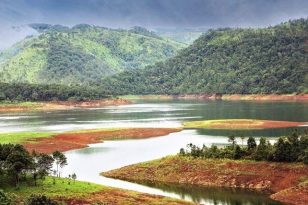| Tour Price | Land only: £ 3200 per person
Prices are all inclusive with no hidden or local payments |
||
| Flights | We can arrange to book flights for you through our partner travel agent or you can arrange your own flights and we will arrange for your transfer from the place where the tour starts | ||
| Activities grade | Trekking Difficult | ||
| Tour Dossier | Download Dossier | Booking Enquiry |
|
Overview
Pemako, located in the far reaches of Eastern Himalayan Arunachal Pradesh is a Beyul. Beyuls are earthly hidden valleys often encompassing hundreds of square kilometers, which Padmasambhava, the 8th Century Indian Buddhist Master also known as Guru Rinpoche blessed as refuges according to the beliefs of the Nyingma school of Tibetan Buddhism. Beyuls can be reached by undertaking arduous journeys to outer worldly places akin to those undertaken by enlightened souls who seek the Buddhist path to liberation. The Pemako is sanctified as the female divinity of Dorje Phagmo and its sacred geography is mapped as the body of this sleeping Goddess. Her head is the Kangri Kangpo, her breasts are Namcha Barwa and Gyala Peri respectively. The lower part of her body lies in Yang Sang or the innermost Pemako which is the upper Siang region of Arunachal Pradesh. At the confluence of Siang (Tsangpo) and Yang Sang is the sacred triangle which is now open to the world to discover and marvel. Every year pilgrims traverse the area for a Kora (circumambulation) covering the sacred Devekota, the gathering place of Dakinis, the holy Teetapori (or Testapuri) mountain, Pema Siri and Riwutala (Eko Dumbing for Adis).
This region lying in the border between India and China was granted access to foreigners only recently. The trek begins in the town of Tuting, the last frontier and where all motorable roads end. The region is home to various different tribes such as Mishmi, Adi, Memba & Khampa; all of them existing in complete peace and harmony with nature, their culture and in their lifestyles. The trek will take you through jungles rich in flora and fauna with medicinal plants, rhododendrons (44 new species discovered as recently as 2005) and endangered flowers. Wildlife in this region include Musk Deer, Tagin, Gorals, Tigers and Snow Leopard. Hunters from the Adi Tribe, visit the region annually to collect aconite poison and offer their prayers to the protector spirits of the mountain.
Detailed Itinerary
Reach Dibrugarh Airport by afternoon, where you will be received by our representative and drive to your hotel. In the evening our tour leader/ guide will come and give you a brief of the tour. Rest of the evening will be at leisure to explore Dibrugarh Town. You can go around and see the busy market area here.
In the morning start your journey towards Pasighat (6 hours) in Arunachal Pradesh. Enjoy the beautiful countryside and landscape of Assam as you drive along. En route you will get to enjoy a ferry ride (2 hrs.) in the mighty Brahmaputra River. Overnight at a hotel.
Drive to Jengging (7 hours/ 2690 feet). The drive will be through bad roads, but the presence of breathtaking valleys of the Siang River will be worth the journey. You may also visit a Adi Tribe authentic village, and walk in sustainable bamboo hanging bridges. Overnight at basic hotel/government guesthouse.
Through pristine landscapes, drive to Tuting (9 hours/1943 feet), the last motorable town, near India’s border with South Tibet. Overnight stay in a basic hotel or government guesthouse.
Buddhist Pilgrimage Trek To Pemako 2017
After breakfast, begin trek to Kuging Village (2786 feet/ 5 hours) by crossing the Siang River in a suspension bridge and through simple villages of the Adi Tribe. The hike will be through terraced farmlands and the Yangsang Chu River, until a climb to Kuging Village, the last village in the route for the coming ten days. Overnight in tents near the village.
Phone No: +44(0) 7552443666
Email id: Info@Wildrhinoadventures.co.uk
After breakfast, trek to Mabi (7205 feet/6 hours). The vegetation will change from tropical and semi-tropical to eventually alpine sanctuaries. The climb is moderate through forests of rhododendrons and pine, though care must be taken against leeches. On clear days, the icy peaks of Namcha Barwa are visible, the ‘left breast of almighty Goddess Dorje Pagmo.’ Overnight at campsite in tents.
A short trek from Mabi to Lama Tukut, with a few uphill walks along ridges, through forests that are a rhododendron fairy- land, along with the breathtaking views of the remote eastern Himalayas (South Tibet). Overnight in tents.
Rest.
Trek to campsite at Kanebenga (10795 feet/5 hours trek). The hike will be mostly along ridges in forests filled with rhododendrons and pines, with terrains eventually changing from barren to rocky. There will be a few uphill and downhill walks. Chinese villages can be seen from here. The surrounding views of mountainside is breathtaking. Overnight in tented accommodation.
Trek to campsite of Pao Lipik (11959 feet/6 hours), leaving the alpine forests and entering barren landscapes filled with beautiful high altitude lakes. The hike will be moderate with uphill and downhill walks, but can be tiresome in the extreme heights. On clear days, the peak of Namcha Barwa is visible. Overnight will be in tents.
Rest.
Trek to Danakosha (13123 fee/5 hours), the sacred lake with the island of tseta (heart). The hike will be through barren ridge of rhododendron scrub until a steep climb to a higher ridge from where you will get magnificent views of the holy Titapori Mountain. The landscape here forms a fully opened lotus. Each year Buddhist pilgrims visit these high isolated ranges to pray in the heart lake, as according to Buddhist Pemako texts, merely seeing this place, a pilgrim opens his consciousness to unlimited knowledge and his/her karma is purified. Overnight at beautiful campsite.
Today, you will do a kora (circumbulation) around five sacred lakes of Danakosha, out of a total of 118 lakes which are believed to occupy this region. These lakes are believed to bless one with tantric powers. On a clear day, the very holy mountain of Kundu Dorsempotrang is visible, which is ‘All Gathering Palace of Vajrasattva’, a tantric deity symbolizing pristine, unobstructed awareness. It is believed that just seeing this mountain liberates a person instantly.
Trek to Wangchen Phukpa (13225 feet/7 hours). The hike will be up and down ridges, crossing Titapori where it is believed that Padmasambhava has hidden many treasures and scrolls. At the campsite of Wangchen Phukpa, one feels on top of the world. The area is abound with exotic wildlife with chances of seeing Musk Deer, Ibex, Takin, Mountain Goat, Red Panda and many species of birds. A tailless rat called locally assaray is found commonly. Overnight in tents.
Buddhist Pilgrimage Trek To Pemako 2017
Rest.
Phone No: +44(0) 7552443666
Email id: Info@Wildrhinoadventures.co.uk
Trek to Dungchen Droma (12500 feet/3 hours), crossing huge boulders fallen down by snow, and then continue through pine and rhododendron forests, until a downhill trail covered with thick bamboo that will end at campsite. On clear days, magnificent views can be seen of the eastern Himalayas. Overnight in tents
Start early for a trek to Tashi Droma (4663 feet/8 hours). It will be a steep downhill hike through forests filled with orchids, bamboos and wild flowers. The vegetation will be thick due to direct sunlight, and care must be taken with the wet slippery ground. The hike will end at River Jiangchu where you’ll cross a cane bridge to arrive at campsite. A swim in the river will be much healing and is highly recommended. Overnight in tents.
Trek to Tashigang Village (3771 feet/4 hours), the first village you will see in ten days. The hike will be along the Jiangchu River in slippery grounds, with moderate uphill and downhill walks. Precaution needs to be taken here against the menacing leeches. The hike ends at Tashigang, a beautiful and quaint little village where 200 people live in 16 houses. Overnight in tents.
Rest.
Begin the trek by visiting the holy site of Dewakota and do a kora around it. Legend says Dewakota Mountain is where Padmasambhava hid many treasure and scrolls, and enlightened persons have the key to finding them. This hike will be a steep descend through huge rocks and eventually crossing a cane bridge and climbing steps to reach Dewakota temple. Later after kora, hike onwards to the village of Mankota. Overnight in tents.
Trek to Payengdam (4017 feet/5 hours), a village located spectacularly at a hilltop which offers excellent views of the mountain ranges. The hike will be gradual with normal climbs. Along with a monastery, a very impressive community centre is established here, supported by pemakodproject.org, for the refugees of China occupied Pemako. Overnight in tents.
Trek back to Tuting by descending alongside the Yangsang River. The hike is steep through tropical forest, until it catches up with the trail of the first day, thus completing one kora (circumbulation). The trek to these remote sacred sanctuaries ends at Tuting for overnight stay at government guesthouse.
Drive from Tuting to Jengging (7 hours). Overnight at government guesthouse
Drive from Jengging to Pasighat (7-8 hours). Overnight at budget hotel/guesthouse.
Buddhist Pilgrimage Trek To Pemako 2017
Pasighat – Dibrugarh
Drive to river port and take a ferry ride to Dibrugarh, sailing in the might Brahmaputra River amidst some spectacular landscapes. Overnight at town’s clubhouse with standard amenities.
Phone No: +44(0) 7552443666
Email id: Info@Wildrhinoadventures.co.uk
Drive to Dibrugarh Airport for return flight home. Tour ends
Inclusions & Additional Information
- All transport in private SUV
- Airport Transfers
- All meals
- All accommodations as per itinerary
- English speaking native tour guide
- Porters, guide, equipments and cook for trek
- Ferry charges
- All taxes
- Protected Area Permit for Arunachal
- Airfares
- Personal expenses
- Alcoholic drinks
Arunachal, literally translating to “the land of the rising sun” is the last frontier state of India surrounded on three sides by Bhutan, China and Myanmar. India’s least explored and remotest state, one needs a permit to enter here. Tucked away in the remote reaches of the Himalayas, only a few of its mountain peaks have been named and numerous yet to be scaled and explored. Its jungles are teeming with various life forms, and houses numerous endangered species of wild life, birds, plants and orchids. It has over 500 bird species (most popular being the Great Indian Hornbill, Masked Finfoot, Sclater’s Monal, Baer’s Pochard, Greater Adjutant, etc.) and new species being discovered in the recent years, making it one of the top birding sites in the world. It is also home to the red panda and rare cats like Clouded Leopard and snow Leopard. The state has 26 major tribes and a number of sub tribes with delicately tattooed faces and pierced skin and their festivals that still see traces of paganism. It is also a place for some famous monasteries and a rich Buddhist culture.
Buddhist Pilgrimage Trek To Pemako 2017
Due to the topographical diversity, the climate in Arunachal Pradesh ranges from sub-tropical to temperate depending upon the altitude. The regions in the lower belts of the state experience hot and humid climates, with a maximum temperature in the foothills reaching up to 40 °C (during the summer). The average temperature in this region in winter ranges from 15° to 21 °C while that during the monsoon season remains between 22° and 30 °C. The areas around the middle belt of Arunachal Pradesh are relatively cooler. The middle belt in Arunachal Pradesh experiences micro thermal climate. Moreover, Arunachal Pradesh possesses an alpine climate in the higher altitudes of the state. The higher regions of Arunachal Pradesh witness snowfall during winter. The snowfall draws large number of tourists to the state from all across the world. Arunachal Pradesh experiences heavy rainfall during May to September. The average rainfall recorded in Arunachal Pradesh is 300 centimeters, varying between 80 centimeters and 450 centimeters.
The night temperatures will be around 5-8 C in the lower areas, and may reach 0-4 C in above 11,000ft. The weather is very unpredictable in Pemako. You can expect some rain and hail stones; otherwise weather will be clear and sunny.
Phone No: +44(0) 7552443666
Email id: Info@Wildrhinoadventures.co.uk
You will be trekking on 17 days out of the 26 days tour and involves high altitude trekking reaching upto 13000 ft. In between there are days of rest. This is a very challenging trek and requires one to have good fitness level. The terrain is hard in Pemako, with 60% climbs at many places. The ground will be slippery at many places for which gum boots will help. Though there’s an itinerary, there may be some changes as the pace of the trek depends on your physical capability. Once in the high reaches, it will be easier than in the wild jungles below. This region has hardly been explored by very few outsiders.
Gums boots have been suggested because there will be lot of mud and slush. There won’t be many leeched as by October they start to disappear. There will insects at many places. A good insect repellant like Odomos is a must.
- Trekking boots should be much higher than ankle. Gum Boots will be best which can be bought in Dibrugarh
- Lots of extra socks
- Cycling tights (dry fits) for upper body to safeguard from insect bites
- Small but good first aid kit (We will also carry some): oral re-hydration salts, altitude medicine, malaria tablets, insect repellant
- blister guards, large alcohol wipes (water is scarce on the initial part of the trek and you will need to freshen up due to perspiration) and any extra personal medicine
- Good hats for protection against the sun in lower areas
- Sunscreen (spf 60 above)
- Rain jackets with hats (we are bound to get rain too!)
- Along with rucksacks/duffel bag, a small day-pack to carry water, snacks, lunch etc. (always carry 2 bottles- one with plain water and one with salts, glucose etc.)
Food is normally Indian, cooked mildly. If you have a dietary requirement, please let us know in advance so that we can make necessary arrangements to the extent possible. In certain circumstances we may not always be able to make suitable arrangements owing to the remote locations and in such a case we will let you know in advance. We strongly advise that travellers with lifethreatening or severe allergies take all necessary medical precautions to prepare for the possibility of exposure. Passengers must travel with all necessary medications for food allergies and be capable of self administering these medications.
We will be using town hotels and in some places, it could be basic accommodation, after Tuting once the trekking starts, accommodation will be in tents that are large sized and comfortable.
Buddhist Pilgrimage Trek To Pemako 2017
A passport (with at least six months remaining validity) and a current Indian visa are required for this trip. Please note that you are required to have a passport with a machine-readable bar code. You will need to apply for your Indian visa in advance from the relevant issuing authority in your home country. British Passport holders can apply for an e-Tourist Visa, a single entry visa valid for 30 days. Please visit the website: www.hcilondon.in/pages.php?id=28
Phone No: +44(0) 7552443666
Email id: Info@Wildrhinoadventures.co.uk
It is recommended that you take out appropriate insurance to cover personal accident, medical costs, repatriation, loss of baggage and holiday cancellation.
Please visit your GP for guidance for vaccinations while travelling to India. Please also visit this website for more details: www.fitfortravel.scot.nhs.uk/destinations/asia-(east)/india.aspx. Please note that the North East India is a malaria prone region and therefore, please carry anti-malaria tablets.
Phone No: +44(0) 7552443666
Email id: Info@Wildrhinoadventures.co.uk






